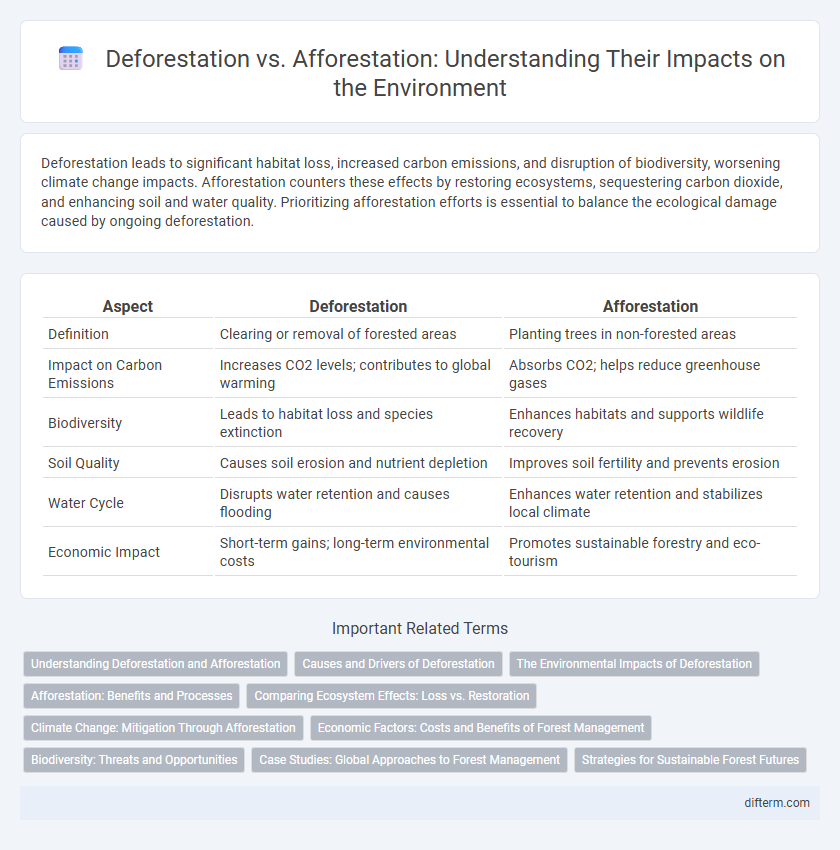Deforestation leads to significant habitat loss, increased carbon emissions, and disruption of biodiversity, worsening climate change impacts. Afforestation counters these effects by restoring ecosystems, sequestering carbon dioxide, and enhancing soil and water quality. Prioritizing afforestation efforts is essential to balance the ecological damage caused by ongoing deforestation.
Table of Comparison
| Aspect | Deforestation | Afforestation |
|---|---|---|
| Definition | Clearing or removal of forested areas | Planting trees in non-forested areas |
| Impact on Carbon Emissions | Increases CO2 levels; contributes to global warming | Absorbs CO2; helps reduce greenhouse gases |
| Biodiversity | Leads to habitat loss and species extinction | Enhances habitats and supports wildlife recovery |
| Soil Quality | Causes soil erosion and nutrient depletion | Improves soil fertility and prevents erosion |
| Water Cycle | Disrupts water retention and causes flooding | Enhances water retention and stabilizes local climate |
| Economic Impact | Short-term gains; long-term environmental costs | Promotes sustainable forestry and eco-tourism |
Understanding Deforestation and Afforestation
Deforestation involves the large-scale removal of forests, leading to habitat loss, decreased biodiversity, and increased carbon emissions that accelerate climate change. Afforestation refers to the process of planting trees in areas previously devoid of forests, enhancing carbon sequestration and restoring ecosystems. Understanding the balance between deforestation and afforestation is critical for sustainable environmental management and mitigating global warming.
Causes and Drivers of Deforestation
Deforestation is primarily driven by agricultural expansion, logging, and infrastructure development, leading to significant loss of forest cover globally. Commercial agriculture, including cattle ranching and oil palm plantations, accounts for the majority of forest clearing in tropical regions. Illegal logging and land tenure conflicts exacerbate deforestation rates, undermining efforts to preserve biodiversity and carbon storage.
The Environmental Impacts of Deforestation
Deforestation leads to significant loss of biodiversity, disrupting ecosystems and accelerating species extinction. It contributes to increased carbon emissions, exacerbating global warming and climate change. Soil erosion and reduced water quality further degrade the environment, impacting agriculture and human health.
Afforestation: Benefits and Processes
Afforestation involves planting trees on lands that have not been previously forested, enhancing carbon sequestration and restoring biodiversity vital for ecosystem stability. It improves soil quality by reducing erosion, increasing water retention, and supporting diverse flora and fauna, contributing significantly to climate change mitigation. The process includes selecting native species, preparing land, and maintaining saplings to ensure sustainable forest growth that benefits both the environment and local communities.
Comparing Ecosystem Effects: Loss vs. Restoration
Deforestation disrupts biodiversity by destroying habitats, leading to species extinction and soil degradation, while afforestation promotes ecosystem restoration through carbon sequestration and habitat creation. The loss of forest cover increases greenhouse gas emissions and alters hydrological cycles, whereas restored forests enhance air quality and stabilize local climates. Comparing these impacts highlights the critical importance of afforestation efforts to reverse environmental damage caused by deforestation.
Climate Change: Mitigation Through Afforestation
Afforestation plays a critical role in climate change mitigation by enhancing carbon sequestration, as newly planted forests absorb significant amounts of atmospheric CO2. Unlike deforestation, which releases stored carbon and exacerbates global warming, afforestation projects contribute to restoring biodiversity and stabilizing local climates. Implementing large-scale afforestation initiatives can effectively reduce greenhouse gas concentrations and support international climate targets such as those outlined in the Paris Agreement.
Economic Factors: Costs and Benefits of Forest Management
Deforestation often yields short-term economic gains through timber sales and land conversion for agriculture, but these benefits are offset by long-term losses in ecosystem services such as carbon sequestration, soil fertility, and water regulation. Afforestation incurs initial costs related to planting, maintenance, and protection but generates sustainable economic returns via enhanced biodiversity, carbon credits, and ecotourism opportunities. Effective forest management balances these trade-offs by quantifying both direct financial expenses and indirect benefits to optimize economic and environmental outcomes.
Biodiversity: Threats and Opportunities
Deforestation severely threatens biodiversity by destroying natural habitats and disrupting ecosystems, leading to species extinction and loss of genetic diversity. In contrast, afforestation creates new habitats and supports ecosystem restoration, enhancing biodiversity and promoting resilience against climate change. These opposing processes critically influence global conservation efforts and ecological balance.
Case Studies: Global Approaches to Forest Management
Case studies from Brazil, Indonesia, and China demonstrate contrasting impacts of deforestation and afforestation on biodiversity and carbon sequestration. Brazil's Amazon deforestation accelerated due to illegal logging, while Indonesia's peatland restoration projects highlight afforestation's role in reducing greenhouse gas emissions. China's large-scale afforestation initiatives have improved soil quality and increased forest cover, serving as a model for sustainable forest management worldwide.
Strategies for Sustainable Forest Futures
Implementing reforestation projects and enforcing strict logging regulations are critical strategies for sustainable forest futures. Integrating community-based forest management and promoting agroforestry enhance biodiversity while supporting local livelihoods. Advances in satellite monitoring and GIS technology enable precise tracking of deforestation rates, aiding targeted conservation efforts.
deforestation vs afforestation Infographic

 difterm.com
difterm.com